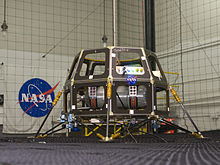Modular Common Spacecraft Bus

The Modular Common Spacecraft Bus (MCSB) is a fast-development, low-cost, general purpose spacecraft platform. Its modular design is intended to reduce the cost, complexity, and lead time on missions by providing a reliable, well-characterized system that can carry a variety of payloads. According to NASA, "the spacecraft is roughly one tenth the price of a conventional unmanned mission and could be used to land on the moon, orbit Earth, or rendezvous with asteroids"[1]
The initial prototype was built by 14 researchers at NASA Ames Research Center in just 15 months with a budget of $4 million. The fast development time is due in part to the novel use of repurposed SCUBA air tanks and a rocket engine that uses cold gas, in place of a conventional fuel/oxidizer or monopropellant engine. This allowed the team to test the system as fast as every 40 minutes in their lab, rather than waiting weeks or months for a time slot at an appropriate testing facility.[2]
Missions
- After a flight demonstration to top NASA officials, the system is being flown as the bus for the Lunar Atmosphere and Dust Environment Explorer (LADEE) mission, a lunar orbiter launching in September 2013.
- Moon Express, a commercial lunar company participating in the Google Lunar X PRIZE competition, is using the MCSB in its MoonEx-1 lander.[3]
References
- ^ NASA Lunar Science Institute, Common Spacecraft Bus for Lunar Explorer Missions, includes video.
- ^ Rowe, Aaron (May 7, 2008). "Exclusive Video: Meet the Spacecraft That Could Save NASA a Fortune". Wired Science (blog).
{{cite web}}: Check|authorlink=value (help); External link in|authorlink= - ^ "Moon Express Technology". Google Lunar X-Prize. November, 2010.
{{cite web}}: Check date values in:|date=(help)
